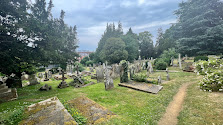 |
The renewed roof of the south transept
of York Minster - from above having climbed
the Great Tower. |
One of the classic “tricks” of even the most noble religious sites one can visit in Great Britain is to channel visitors to a designated exit. Exiting is not the trick. The trick is that to get to that point you must first pass through the gift shop, which is filled with everything from labelled jams and jellies to high-end crystal models of the edifice you are trying to leave! I have never been one for souvenirs of my travels and my sabbatical treks were no exception. There was one thing, however, that caught my eye. I stopped and considered its cost and whether it was worth my time and money. I decided not and left through the proper gate.
But once in the courtyard, it nagged at me. That one item had triggered something in my imagination, perhaps because it touched an element of my life that is so important to me. So much so, that I returned to the shop through the “exit” (which was an entrance from this side!) and reconsidered. I decided finally to inquire and ultimately bought the one real souvenir of my journey.
 |
The collapsed roof of the south
transept at York Minster - 1984
(photo © PA downloaded from BBC.com) |
On 9 July 1984, York Minster suffered a serious fire in its south transept during the early morning hours. Firefighters decided to deliberately collapse the roof of the south transept by pouring tens of thousands of gallons of water onto it to save the rest of the building. Tests concluded the fire was “almost certainly” caused by lightning striking a metal electrical box inside the roof.
Few of the timbers that crashed to the floor could be salvaged. From these timbers came the one souvenir I will treasure – a fountain pen sculpted from the ancient English oak that once held the mighty roof aloft.
As you know, I love to write. For many years, I have kept a journal of my thoughts as I made my way though the twists, turns, and challenges of life. These journals are handwritten. I have periodically tried to keep a journal electronically, but this was never a successful endeavor. There is something about the process of literally “putting pen to paper” that sparks my imagination and thought process. Often, a few sentences turn into pages. I have always had a love of writing – not only composing – but the actual writing – whether it be thank-you notes for gifts or letters of support and care to friends and family. Regrettably, stationery stores are few these days so quality papers are hard to find. But I can always rely on the quality pens I have collected over the years – and the inks that fill them.
Beth Yocum discovered this one day. Thanks to her thoughtfulness, my collection both of pens and inks has grown. These gifts, like my newest souvenir, are not only functional, but carry memories with them, memories that are touched each time one of these instruments is used in service of my thoughts.
 |
The pen made from the
oak timbers of York Minster |
There is something about the writing that is consistent with our understanding of sacraments. One of these days, when my mortal remains lie in the dust, someone may open one or another of these journals and discover something about my innermost thoughts. Paper, ink, and pens will speak thoughts that no longer can be expressed with breath. They are, unlike the whisps of corruptible and forgettable electronic document files, a permanent, stable reminder of something that was alive and true – a physical presence of a spiritual reality - a sort of sacrament.
That pen, spun on a lathe and formed from a charred piece of ancient English oak, not only held up a roof, but also held witness to countless monks' prayers, the cries of infants at the baptismal font, the ordinations of deacons, priests, and bishops, the joining of couples in wedlock, souls being laid to rest, sermons preached, souls shriven, and more in the centuries old saga of York Minster. Each of these I hold in my hand as I put my own thoughts to paper, and, I pray, form a connection with those holy souls that I may be the priest I ought to be.

















